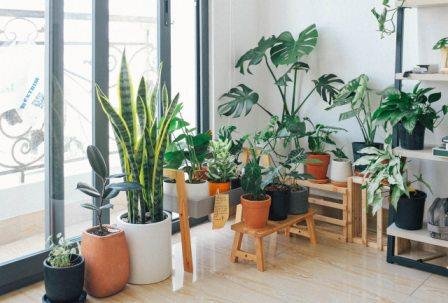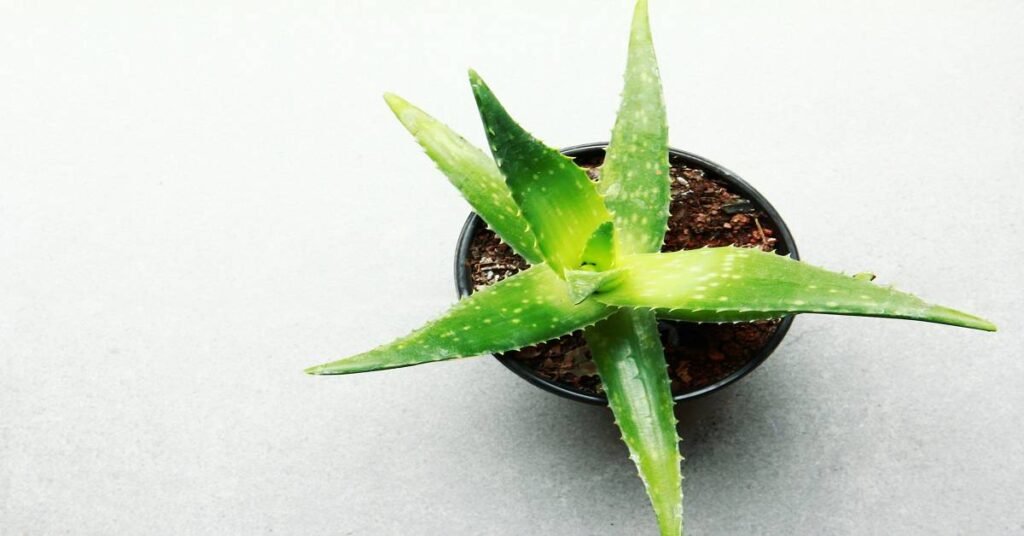Table of Contents
In this article, we will be discussing how you can make your home air clean with the help of the Best Air Purifying Plants. Clean air is a basic necessity; everyone wants to breathe in clean air but the least you know is your home might be home to more harmful pollutants than outside. Cosmetics, air fresheners, craft supplies, paint, detergent, and even household cleaners can release a lot of toxic compounds like formaldehyde, benzene, and many more. These toxic compounds are hazardous for human health, plants, and animal life.

Short-term exposure to these compounds can irritate (the nose, mouth, and throat), drowsiness, and headache. Buying an air purifier is the best option, but air purifiers are expensive, So researchers have found a cheaper and simpler alternative to removing indoor air pollutants: houseplants.
Plants not only clean the air by absorbing carbon dioxide from the air and releasing oxygen through photosynthesis. But they also provide a natural way of cleaning toxins such as benzene, formaldehyde, trichloroethylene, xylene, and toluene from the air.
8 Common Indoor Air Pollutants Found In Your Home
As we have already mentioned, indoor air is more polluted than outdoor air, pollutants present in indoor air can be even more dangerous than outdoor air.
Here we have covered the 8 common indoor air pollutants.
1. Carbon monoxide (CO)
Carbon monoxide is a colorless, odorless, invisible gas. It stops your body from using the oxygen needed to perform normally, You may experience tiredness, headaches, dizziness, nausea, and a faster heart rate.
A higher concentration of carbon monoxide could lead to death. You need to make sure that all the combustion appliances, such as heater, have been installed correctly at your home. Do not use them without vents inside.
2. Nitrogen dioxide (NO2)
Nitrogen dioxide (NO2) is also a product of poor combustion. It is a toxic and corrosive gas. Exposure to a high level of Nitrogen dioxide can lead to lungs irritation and moderate level exposure can cause acute or chronic bronchitis. You need to ensure that combustion Sources such as ovens and stoves are properly installed.
3. Formaldehyde
Formaldehyde is used in flooring, carpets, curtains, compressed wood furniture. It is also Found in paper bags, waxed papers, facial tissues, paper towels, and synthetic fabrics.
Short-term exposure to formaldehyde can cause irritation to the nose, mouth, and throat, and long term exposure can cause swelling of the larynx and lungs. Your house also needs good ventilation and possible removal of the source.
4. Benzene
Benzene is used to make plastics, resins, lubricants, detergents and is also found in tobacco smoke, glue, and furniture wax. Short-term exposure to benzene can cause irritation to the eyes, drowsiness, dizziness, headache, increased heart rate, and much more
5. Trichloroethylene
Trichloroethylene is found in printing inks, paints varnishes, adhesives, and paint removers. Short-term exposure to which can cause dizziness, headache, nausea, and vomiting followed by drowsiness and coma.
6. Xylene
Xylene is found in rubber and leather. short-term exposure to it can cause irritation to mouth and throat, dizziness, headache, heart problems, liver, and kidney damage
7. Ammonia
Ammonia is a colorless gas. It is found in window cleaners, floor waxes, and fertilizers. It’s short-term exposure can cause eye irritation, coughing, and sore throat.
8. Suspended Particulate Matter
Suspended Particulate Matter refers to the solid and liquid particles suspended in the air that are too small in size to be seen with the naked eye. Its short-term exposure can cause irritation of the eyes and the respiratory tract, and long-term exposure can cause asthma and weaker cardiovascular function.
List Of 12 Best Air Purifying Plants NASA Recommended
We have prepared a list of NASA recommended Best Air Purifying plants for your home, that surely will make a difference in the air inside your home.
1.Snake Plant
Snake plant is also known as Mother-In-Law’s Tongue. It is really easy to take care of this plant. Snake plant requires occasional watering and prefers drier conditions, as long as your room gets some sunlight you’ll be good to go. It purifies the air by producing oxygen and removing pollutants such as benzene, formaldehyde, trichloroethylene, xylene, and toluene. All these qualities make it one of the best air purifying plants for your home.
2.Spider Plant
Spider plant is one of the easiest plant to find and to take care of, making them a great plant to begin with. It is a popular plant and can be found in many homes. Most people have owned one at some point of their life. This is a plant, many of us had in our home while growing up.
Once it begins to mature it produces lots of plant-lets (small plants) that can be propagated. Spider plant removes toxins including, carbon monoxide and xylene. If you own pets, this is one of the few houseplants that are non-toxic to animals.
3.Areca Palm
Areca palm is one of the most popular grown-in-door plants. It is very effective in cleaning formaldehyde, xylene, and toluene from the air. Multiple cane-like stems grow from the root system and produce attractive arching fronds, with quite narrow leaflets. It is one of the most attractive indoor plants.
4.Aloe Vera
Aleo Vera is a plant with many benefits. We can also say it is one of the most giving plants. It produces a soothing gel which is an instant remedy for burns healing, and it is also beneficial for skin conditions like eczema, psoriasis, and insect bites.
It’s great to keep it in your kitchen for quick relief from any burns or wounds. You only need to break off one of the spike and squeeze the gel out. It grows in full sunlight. It cleans the air by removing toxins like formaldehyde and benzene.
5.Ficus(Weeping Fig)
Weeping Fig is one of the best plant for cleansing air-borne toxins like formaldehyde, xylene, and toluene, which can build up from carpet and furniture cleaners or stain removers. It is one of the favorite ornamental plants in many households.
This plant is toxic to cats and dogs, so keep them away from them. On the bright side, Ficus is pretty easy to care of, Just keep them out of the direct sunlight and allow the soil to get pretty dry before watering again.
6.Dracaenas
Dracaenas is a well-known indoor plant for those of you who want something different for your home. There are over 40 different types of Dracaenas. It purifies the air by removing harmful toxins like trichloroethylene, which can come from household paint, varnish removers, and even adhesives.
This plant is toxic for pets, so pet owners beware of having this plant in your home. This plant is an easy to take care of as it needs a medium amount of sunlight and low watering.
7.Peace Lily
Peace lily is not just pleasing and relaxing to the eyes, but it is also one of the super plants to filter out harmful toxins like benzene, formaldehyde, trichloroethylene, ammonia, xylene, toluene, and many more. It is a beautiful plant offering white flowers.
This plant helps in improving the humidity as they have a high transpiration rate. It reduces dust in rooms and can calm any irritants to your eyes, nose, and mouth. You should keep it out of your pet’s reach as it is toxic for pets.
8.English Ivy
English Ivy is another popular indoor plant that helps in reducing level of trichloroethylene, formaldehyde, xylene, ammonia, and benzene which can be found in a lot of products. English Ivy is simple to grow and needs moderate sunlight.
It is also great for your bathroom because it is said to help remove mold. It is also toxic to your kids and pets, so make sure to keep it out of their reach.
9.Chrysanthemum
Chrysanthemum is an inexpensive and air purifying champion that removes common toxins like formaldehyde, xylene, ammonia, and benzene from the air. This plant is very popular and it adds colors to your home.
They come in many colors including white, orange, yellow, and pink. This plant is also toxic for your Pets, so you need to keep that in mind.
10. Gerbera Daisy
Gerbera Daisy
Gerbera Daisy brightens your home and lifts your spirit, and they are for sure the prettiest entry on the list. This beautiful plant is effective at removing harmful toxins such as benzene and trichloroethylene. You must provide bright light to keep your plant happy; water the plant deeply whenever the top inch of soil feels dry.
11.Devil’s Ivy
Devil’s Ivy also known as Pothos or money plant, is an easy to grow popular house plant. Devil’s ivy effectively removes xylene, benzene, formaldehyde, and trichloroethylene from the air. It grows well in water, pots, and hanging baskets. It is toxic to pets, so make sure to keep it out of their reach.
12.Rubber plants
The rubber plant is an inexpensive and easy-to-grow option if you are looking for an air purifying plants for your home. It grows well in low light conditions and needs infrequent watering. Rubber plant improves your homes air quality by removing formaldehyde, carbon dioxide, and carbon monoxide from the air. It is also beneficial for wounds, cuts, and sores.
Conclusion
Plants are great for every home. They give a fresh feeling to your home as well as purify your home air. In this article, we have covered the NASA recommended 12 Best Air Purifying Plants for every home. For the best air quality of your home, you can use them with the Best Air Purifier available in the market.
Please drop us a comment in case you have any query.
Related Post:














Lovely Article. I’ll get some plants for my home.
Thank you 👍